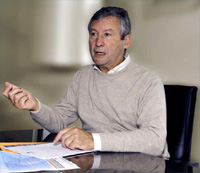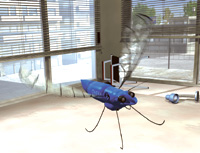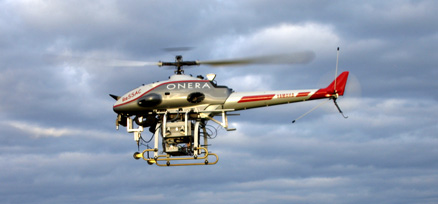Today, drones are generally piloted by ground-based operators. But a number of research organizations, including Onera, are trying to make them more autonomous, in order to increase their operational effectiveness. We asked Claude Barrouil, head of Onera’s Information Processing and Systems branch, to shed some light on drone autonomy…
|
InterviewAren’t today’s drones already autonomous? |
|
| Claude Barrouil: Not really. To simplify things a bit, you could say that the drones in operation today are a sort of “automaton”, remote-controlled by operators on the ground. Some already incorporate very advanced automated systems. For instance, most drones are capable of reaching the mission zone by themselves. But their operators then take over. However, both designers and users would like to boost this autonomy, by giving drones the ability to make certain decisions on their own. Since the operator is located far away, he is not always fully aware of the situation, and "onboard intelligence" could be more effective in reacting to unexpected events. |  Claude Barrouil, head of Onera’s Information Processing and Systems branch |
|
Doesn’t the autonomy issue only apply to military or armed drones? C.B.: No, it also applies to the space sector, police forces and customs services (border surveillance or maritime operations, for instance), and even land transport, if we eventually get around to developing automated highways. What are the main difficulties to be resolved to achieve this autonomy? C.B.: One of the most important is perception, in the broad sense of the term. If drones are to become more autonomous, they have to be capable of gathering information on their environment, understanding this information, and then reacting to what they understand, even if it’s only to decide that they still need more information before acting! That imitates the behavior of intelligent beings. And this perception must function in two directions. In what sense? C.B.: First of all, it has to be turned inwards, to detect anomalies and failures. The drone has to be capable of reconfiguring itself, of adapting so it can complete its mission or return to base in good shape. We call that function FDIR (Fault Detection Isolation and Recovery). This is a critical function, especially for spacecraft, which may be dispatched on very long missions. Secondly, it has to perceive the outside environment of course. Drones are generally designed for observation and/or intelligence missions. But while current models collect data and images, they don’t analyze this information – it’s the operator on the ground who handles that task. Increasing their autonomy therefore means increasing their ability to process and analyze information onboard. For example, take an armed drone that’s been sent on a mission to destroy enemy batteries. It would be an advantage if this drone could recognize and identify these batteries, and therefore help the operator make a correct, timely decision. The drone would alert the operator when it has detected a likely target, and will ask for a simple confirmation before triggering the attack. The aim is not to replace the operator, but to provide as much backup support as needed so the operator can concentrate on critical decisions under the best conditions, especially on whether to fire or not. Furthermore, this onboard assistance in interpreting the images means we can reduce the volume of information transmitted over the datalink. Is it possible to envisage a drone capable of making its own decisions on weapon use? C.B.: The French armed forces are very clear on this question: people must absolutely retain final-decision authority on the use of a weapon. There must not be the slightest ambiguity on sharing of authority between man and machine. The aim is rather for the drone to be capable of providing the operator with full awareness of the situation, using its onboard sensors. Is Onera working on this question of perception? C.B.: Of course. Perception is a key part of the research program dubbed SPIDER (dynamic perception and interpretation system for urban environments). We’re very fortunate at Onera in that we have the complementary areas of expertise needed to address these subjects, namely optics, optronics, synthetic aperture radars (SAR), image processing, online planning and control. This gives us a real advantage in terms of developing solutions and moving forward. What else do we need to improve to enhance drone autonomy? C.B.: A drone comprises a number of functions that are still rather independent of each other, including updating mission plans, managing mobility, perception, collaboration between agents, managing communications, etc. We still don’t fully understand all these facets, and more research is needed. Furthermore, we have to do something like what nature did with our brains, that is, integrate all these functions within a whole that is capable of coordinating all actions. Onera has a certain level of experience in this area. For instance, we already developed the decision-making architecture for a submarine drone a dozen years ago. We also set up the AMAO research program to offer a complete onboard software architecture for an armed drone. And then we come to human factors: even a highly autonomous drone is only advantageous if it remains under the control of a ground operator. And doesn’t drone autonomy also raise the issue of safety? C.B.: If we want to facilitate drone operations, we must in fact guarantee that they do not endanger the population. A drone used to monitor a forest fire or inspect a bridge can’t run the risk of crashing into the neighbors! This implies the need for certification, as is already the case for commercial jetliners. In the future, drones should no longer be considered as a special kind of air vehicle, but rather as ordinary aircraft, subject to the same flight safety requirements. This aspect has to be integrated right from the design stage, so that it will be easier to prove that they satisfy the requirement for a reasonable risk. Onera has certain advantages in this area: for instance, we have extensive experience in engineering safety-critical and dependable systems, abbreviated RAMS (reliability, availability, maintainability, safety). As part of the AIRSYS partnership with Airbus, we’re making a strong contribution to new transport aircraft in terms of system engineering. We have launched a research program called IDEAS to define the methodology and tools needed for the integration of drones in civilian airspace. Do you think that drones will eventually be able to operate on their own? C.B.: We’re not going to change overnight from remote-controlled drones to completely autonomous drones. The transition will undoubtedly be gradual. I believe that drones will progressively be outfitted with increasingly advanced assistance functions. That means the operator will consider the drone a service resource, and he will sent requests. This entire approach will have an impact on operational concepts for transport aircraft. Advances in autonomy will provide benefits to assist pilots, and perhaps the day will come when we take an unpiloted aircraft just like we now take a driverless subway without thinking twice. Technical supplements
|
|
|
 A concept of Onera’s Remanta microdrone project, inspired by the dragonfly (artist’s view) |
| Of course, not just any old eyes, as Guy explains : « We aim to develop innovative systems that associate, from the outset, the sensor, image processing and drone control systems – an approach that draws its inspiration from nature. Some animals, especially insects, achieve remarkable flight performance by intimately combining perception and motor skills.» Another aspect of the project is “self-positioning”, or the ability of a drone to know where it is at all times, even without a GPS signal. It also focuses on the detection, recognition and identification functions. « We’re trying to give drones advanced perception functions,» concludes Guy Le Besnerais, «such as target detection and tracking in urban environments, in order to lighten the operator’s workload." | |





